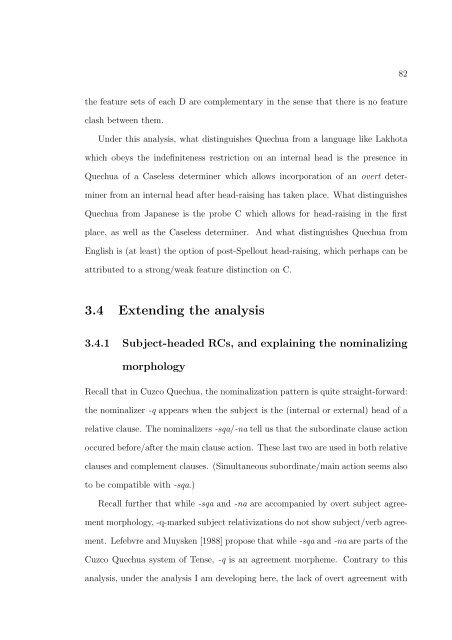the syntax and semantics of relativization and quantification
the syntax and semantics of relativization and quantification
the syntax and semantics of relativization and quantification
You also want an ePaper? Increase the reach of your titles
YUMPU automatically turns print PDFs into web optimized ePapers that Google loves.
82<br />
<strong>the</strong> feature sets <strong>of</strong> each D are complementary in <strong>the</strong> sense that <strong>the</strong>re is no feature<br />
clash between <strong>the</strong>m.<br />
Under this analysis, what distinguishes Quechua from a language like Lakhota<br />
which obeys <strong>the</strong> indefiniteness restriction on an internal head is <strong>the</strong> presence in<br />
Quechua <strong>of</strong> a Caseless determiner which allows incorporation <strong>of</strong> an overt determiner<br />
from an internal head after head-raising has taken place. What distinguishes<br />
Quechua from Japanese is <strong>the</strong> probe C which allows for head-raising in <strong>the</strong> first<br />
place, as well as <strong>the</strong> Caseless determiner. And what distinguishes Quechua from<br />
English is (at least) <strong>the</strong> option <strong>of</strong> post-Spellout head-raising, which perhaps can be<br />
attributed to a strong/weak feature distinction on C.<br />
3.4 Extending <strong>the</strong> analysis<br />
3.4.1 Subject-headed RCs, <strong>and</strong> explaining <strong>the</strong> nominalizing<br />
morphology<br />
Recall that in Cuzco Quechua, <strong>the</strong> nominalization pattern is quite straight-forward:<br />
<strong>the</strong> nominalizer -q appears when <strong>the</strong> subject is <strong>the</strong> (internal or external) head <strong>of</strong> a<br />
relative clause. The nominalizers -sqa/-na tell us that <strong>the</strong> subordinate clause action<br />
occured before/after <strong>the</strong> main clause action. These last two are used in both relative<br />
clauses <strong>and</strong> complement clauses. (Simultaneous subordinate/main action seems also<br />
to be compatible with -sqa.)<br />
Recall fur<strong>the</strong>r that while -sqa <strong>and</strong> -na are accompanied by overt subject agreement<br />
morphology, -q-marked subject <strong>relativization</strong>s do not show subject/verb agreement.<br />
Lefebvre <strong>and</strong> Muysken [1988] propose that while -sqa <strong>and</strong> -na are parts <strong>of</strong> <strong>the</strong><br />
Cuzco Quechua system <strong>of</strong> Tense, -q is an agreement morpheme. Contrary to this<br />
analysis, under <strong>the</strong> analysis I am developing here, <strong>the</strong> lack <strong>of</strong> overt agreement with
















